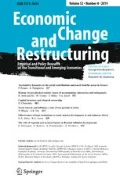Abstract
This study examines the effects of oligarch ownership on corporate capital structures. Using panel data from Ukraine, I find that oligarch–owned companies employ significantly more debt and liabilities than their peers. However, there is no direct relation between oligarch ownership and target capital structure. Whereas the determinants of target leverage are similar across all owners, differences in firm characteristics also have a fairly small effect. I show that larger leverage is due to better access to debt, which results in lower rebalancing costs and faster restructurings of oligarch–owned companies. The findings clearly suggest that oligarchs benefit from the accumulated advantages.

Similar content being viewed by others
Notes
The term “oligarch” denotes a post-Soviet industrial and/or financial magnate (usually Russian or Ukrainian) who “controls sufficient resources to influence national politics” (Guriev and Rachinsky 2005).
“For whoever has will be given more, and they will have an abundance. Whoever does not have, even what they have will be taken from them”—The Bible (New International Version), Matthew 25:29.
See KyivPost, “Government nationalizes PrivatBank, guarantees deposits” (Dec. 18, 2016) and BBC, “Ukraine’s biggest lender PrivatBank nationalised” (Dec. 19, 2016).
Stock Market Infrastructure Development Agency of Ukraine database, http://smida.gov.ua.
The first-ever ranking was published by Korrespondent in 2006. Focus launched its rating in 2007, whereas Forbes (Ukraine) published its first ranking in 2011. Several available rankings include fewer or greater than 100 persons.
Industries are classified according to international standard industrial classification of all economic activities (Rev.4). See industry composition of the dataset in Appendix 1.
As mentioned earlier, firm selection during the privatization was not random. Nevertheless, it is not clear to what extent differences between oligarch and non-oligarch firms come from non-random selection of ownership.
References
Baum CF, Caglayan M, Schäfer D, Talavera O (2008) Political patronage in Ukrainian banking. Econ Transit 16(3):537–557
Booth L, Aivazian V, Demirguc-Kunt A, Maksimovic V (2001) Capital structures in developing countries. J Finance 56(1):87–130
Chang SJ, Hong J (2000) Economic performance of group-affiliated companies in Korea: intragroup resource sharing and internal business transactions. Acad Manag J 43(3):429–448
Charumilind C, Kali R, Wiwattanakantang Y (2006) Connected lending: Thailand before the financial crisis. J Bus 79(1):181–218
De Haas R, Peeters M (2006) The dynamic adjustment towards target capital structures of firms in transition economies. Econ Transit 14(1):133–169
Dinç IS (2005) Politicians and banks: political influences on government-owned banks in emerging markets. J Financ Econ 77(2):453–479
Driffield N, Mahambare V, Pal S (2007) How does ownership structure affect capital structure and firm value? Recent evidence from East Asia. Econ Transit 15(3):535–573
Ebrahim MS, Girma S, Shah ME, Williams J (2014) Dynamic capital structure and political patronage: the case of Malaysia. Int Rev Financ Anal 31:117–128
Faccio M (2006) Politically connected firms. Am Econ Rev 96(1):369–386
Faccio M, Masulis RW, Mcconnell JJ (2006) Political connections and corporate bailouts. J Finance 61(6):2597–2635
Fama EF, French KR (2002) Testing trade-off and pecking order predictions about dividends and debt. Rev Financ Stud 15(1):1–33
Fisman R (2001) Estimating the value of political connections. Am Econ Rev 91(4):1095–1102
Flannery MJ, Rangan KP (2006) Partial adjustment toward target capital structures. J Financ Econ 79(3):469–506
Fraser DR, Zhang H, Derashid C (2006) Capital structure and political patronage: the case of Malaysia. J Bank Finance 30(4):1291–1308
Gokhberg L, Roud V (2016) Structural changes in the national innovation system: longitudinal study of innovation modes in the Russian industry. Econ Change Restruct 49(2):269–288
Gorodnichenko Y, Grygorenko Y (2008) Are oligarchs productive? Theory and evidence. J Comp Econ 36(1):17–42
Guriev S, Rachinsky A (2005) The role of oligarchs in Russian capitalism. J Econ Perspect 19(1):131–150
Ivashkovskaya IV, Solntseva MS (2007) The capital structure of Russian companies: testing trade-off theory versus pecking order theory. J Corp Finance Res 1(2):17–31
Jensen MC (1986) Agency costs of free cash flow, corporate finance, and takeovers. Am Econ Rev 76(2):323–329
Jensen MC, Meckling WH (1976) Theory of the firm: managerial behavior, agency costs and ownership structure. J Financ Econ 3(4):305–360
Jõeveer K (2013) Firm, country and macroeconomic determinants of capital structure: evidence from transition economies. J Comp Econ 41(1):294–308
Khwaja AI, Mian A (2005) Do lenders favor politically connected firms? Rent provision in an emerging financial market. Q J Econ 120(4):1371–1411
Manos R, Murinde V, Green CJ (2007) Leverage and business groups: evidence from Indian firms. J Econ Bus 59(5):443–465
Maury B, Liljeblom E (2009) Oligarchs, political regime changes, and firm valuation. Econ Transit 17(3):411–438
Myers SC (1977) Determinants of corporate borrowing. J Financ Econ 5(2):147–175
Nivorozhkin E (2004) The dynamics of capital structure in transition economies. Econ Plan 37(1):25–45
Nivorozhkin E (2005) Financing choices of firms in EU accession countries. Emerg Mark Rev 6(2):138–169
Pöyry S, Maury B (2010) Influential ownership and capital structure. Manag Decis Econ 31(5):311–324
Rajan RG, Zingales L (1995) What do we know about capital structure—some evidence from international data. J Finance 50(5):1421–1460
Saeed A, Belghitar Y, Clark E (2015) Political connections and leverage: firm-level evidence from Pakistan. Manag Decis Econ 36(6):364–383
Saeed A, Belghitar Y, Clark E (2017) Political connections and firm operational efficiencies: evidence from a developing country. Rev Manag Sci 11(1):191–224
Stephan A, Talavera O, Tsapin A (2011) Corporate debt maturity choice in emerging financial markets. Q Rev Econ Finance 51(2):141–151
Strebulaev IA (2007) Do tests of capital structure theory mean what they say? J Finance 62(4):1747–1787
Welch I (2011) Two common problems in capital structure research: the financial-debt-to-asset ratio and issuing activity versus leverage changes. Int Rev Finance 11(1):1–17
Acknowledgements
I thank two anonymous referees for valuable comments and suggestions. All remaining errors are mine.
Author information
Authors and Affiliations
Corresponding author
Appendices
Appendix 1. Detailed dataset statistics
Appendix 2. Robustness checks
This appendix discloses the following robustness checks (see text for the further details):
See Tables 9, 10, 11, 12, 13, 14, 15 and 16.
Rights and permissions
About this article
Cite this article
Chernenko, D. Capital structure and oligarch ownership. Econ Change Restruct 52, 383–411 (2019). https://doi.org/10.1007/s10644-018-9226-9
Received:
Accepted:
Published:
Issue Date:
DOI: https://doi.org/10.1007/s10644-018-9226-9




